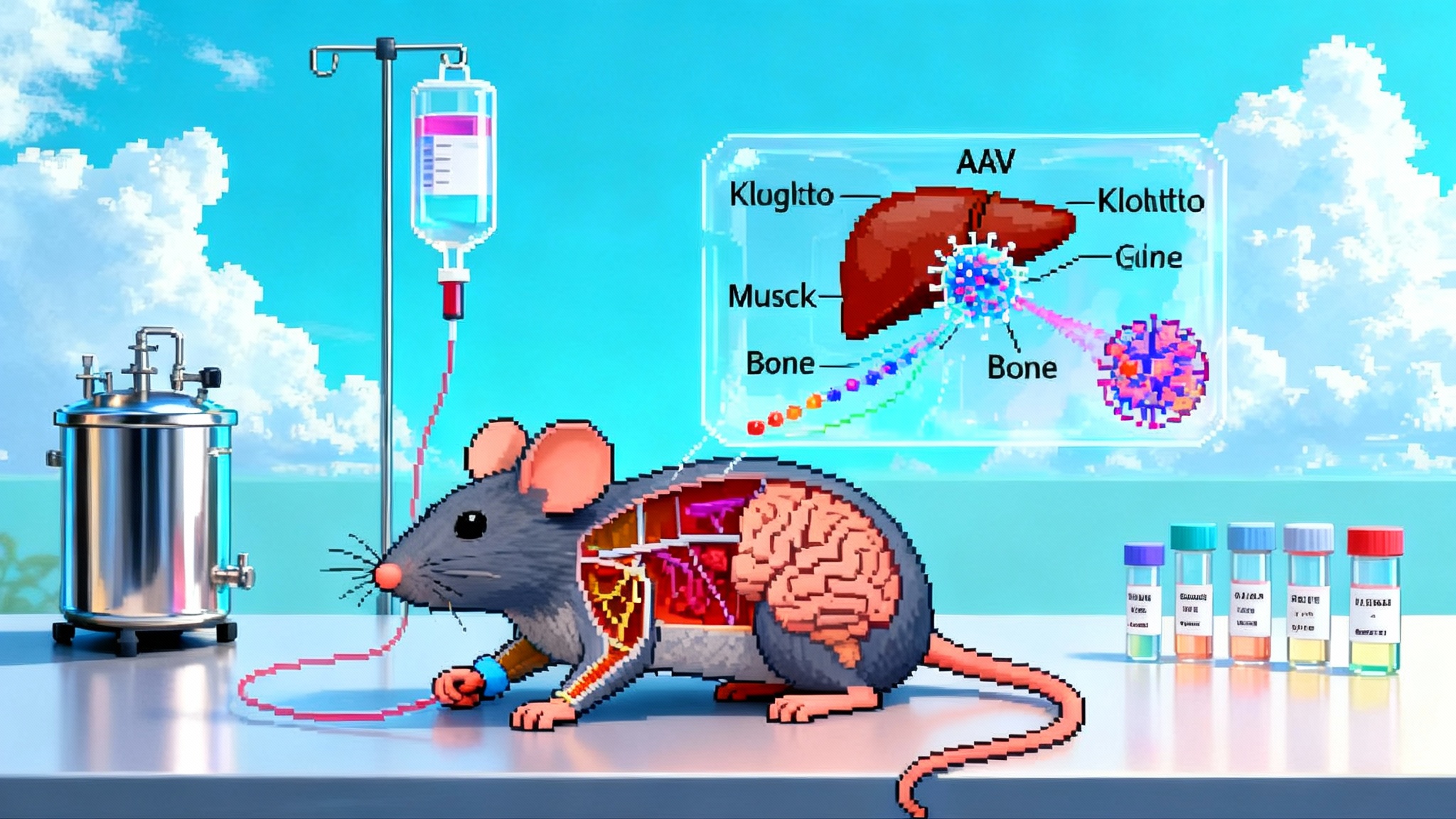GPX4 Senolytics Hit Clinic: Rubedo’s RLS‑1496 Moves Into Humans
Rubedo dosed its first patient with RLS-1496 in May 2025, launching the first human test of a GPX4-modulating senolytic. Here is how ferroptosis could define senolytics 2.0, which skin biomarkers will matter, and what a credible 2026 systemic program could look like.

A turning point for senolytics
In late May 2025, Rubedo Life Sciences dosed the first patient with RLS-1496, a topical small molecule that modulates GPX4 to target senescent cells. The single-center, randomized, double-blind, vehicle-controlled study is running in the Netherlands with roughly two dozen adults who have stable plaque psoriasis. The protocol begins with single dosing and then moves to multiple dosing, tracking safety, tolerability, pharmacokinetics, and pharmacodynamics. A key clinical readout in lesions is the modified Investigator’s Global Assessment, and the team is also sampling aging skin to look for shifts in biomarkers that reflect biological age. Rubedo also flagged a plan to take a systemic formulation into first-in-human testing in 2026. All of this makes RLS-1496 the first GPX4 modulator to enter human studies and turns the spotlight on ferroptosis as a senolytic strategy. Those facts were set out when the company announced the first patient dosed in May 2025.
This is more than another early phase trial. It is an inflection point for a field that has promised selective clearance of pathological senescent cells for nearly a decade but has struggled to deliver clean safety and convincing human biomarkers. The first wave leaned on apoptosis pathways and often ran into dose-limiting issues or ambiguous pharmacology. RLS-1496 plants a new flag by aiming to nudge a different cell-death program that senescent cells may be primed to enter.
Why GPX4 and ferroptosis could define senolytics 2.0
Senescent cells accumulate with age and disease, resist apoptosis, and secrete pro-inflammatory factors that reshape local tissues. They are a moving target, and the earliest senolytic regimens tended to use broad stressors or BCL-2 family inhibitors. That approach can work in selective contexts, but it also risks collateral damage. The big idea behind GPX4 modulation is to exploit a weakness that emerges as cells age and become chronically inflamed.
GPX4 is a gatekeeper enzyme that reduces lipid peroxides in membranes. When GPX4 activity is insufficient, iron-driven lipid peroxidation spirals and the cell tips into ferroptosis, a regulated, non-apoptotic form of death. Multiple groups have shown that senescent cells can exhibit higher iron load, altered redox set points, and dependence on GPX4 buffering. In preclinical systems, pushing these cells over the edge with targeted ferroptosis triggers has selectively eliminated them while sparing healthier neighbors. One representative study found that senescent epithelial cells were sensitized to ferroptosis and that tweaking the GPX4 axis enhanced selective clearance in aged tissue slices. That concept is captured in work showing that ferroptosis selectively eliminates senescent cells.
The bet with RLS-1496 is not to carpet-bomb skin or systemically deplete GPX4. It is to tune local GPX4 activity or its neighborhood so that pathological senescent cells, already perched near the ferroptotic threshold, are the first to go. If the drug is truly selective in vivo, the result should look like reduced senescent cell burden, a quieter inflammatory microenvironment, and, potentially, healthier tissue function.
Inside the skin trial: what the first readout will actually tell us
Topical dermatology trials offer a rare chance to pair clinical measures with deep tissue biology. That is why this first step uses psoriatic lesions and aging skin. Expect three categories of evidence to matter.
1) Safety and local tolerability
- Adverse events and local skin reactions: erythema, edema, pruritus, burning, or pain at the site. Dermatology studies grade these carefully, and the bar for a topical is high.
- Pharmacokinetics: plasma exposure should be minimal with topical dosing. Low or transient systemic levels strengthen the case for safety and for a large therapeutic window before the systemic program begins.
- Standard labs and vital signs: no off-target safety signals in liver enzymes, renal markers, or hematology. Photosafety is not usually a headline risk for a GPX4 modulator, but investigators will watch for phototoxic patterns or pigment changes.
2) Clinical signal in lesions
- mIGA shift in treated plaques: early movement in scores over a short window would be encouraging, but small N means wide confidence intervals.
- Secondary measures that sites often track: lesion thickness, scaling, and symptom relief. Any separation from vehicle would support continued exploration in inflammatory dermatoses beyond psoriasis.
3) Biomarkers of cellular aging and senescence
- Senescence markers: p16INK4a and p21Cip1 in epidermis and dermis via immunohistochemistry or transcript assays. A paired biopsy design is ideal. A reduction in p16 or p21 positive cells after treatment would suggest senescent cell clearance rather than only immune dampening.
- The SASP signature: IL-6, IL-8, TNF, TGF-beta pathway mediators, and matrix metalloproteinases in tissue, tape strips, or microdialysate. A meaningful downward shift would indicate the environment is less inflammatory and catabolic.
- Epigenetic clocks for skin: DNA methylation panels that have been optimized for cutaneous tissue can estimate biological age. This dovetails with the policy dynamics in FDA LDT rollback on biomarkers, which has helped return aging assays to clinical settings. A small decrease in estimated skin age after several weeks would be provocative. It will not prove rejuvenation on its own, but coupled with senescence and SASP changes it would add weight.
- Collateral tissue stress measures: lipid peroxidation adducts and oxidative stress markers can help confirm on-target pharmacology without harming healthy cells. If these rise sharply in non-lesional skin, that would be a caution sign.
The sponsor has previewed an intent to interrogate aging biomarkers in skin. The most credible story will be coherent across layers: clinical improvement in plaques, fewer p16 or p21 positive cells where drug is applied, a quieter SASP, and a modest but consistent epigenetic age shift in the same direction. Histology that shows healthier collagen architecture and normalized keratinocyte differentiation would round out the picture.
Reading the tea leaves without overreading
A small Phase 1 is not built to settle debates. The most it can do is align safety, pharmacology, and early efficacy. With topical delivery, there is always a risk that a drug “works” by being anti-inflammatory in a generic way rather than selectively removing problem cells. This is where the biomarker package matters. If you see reduced p16 and p21 staining in treated skin with parallel SASP downshifts, and you do not see the same in vehicle-treated sites, the specificity story strengthens. The importance of predefining analyses and avoiding overinterpretation echoes lessons from rapamycin trial’s real-world signals.
The epigenetic clock adds a different kind of signal. It integrates many methylation changes that track with age and disease, but it is sensitive to inflammation and other short-term perturbations. A credible analysis will predefine the clock used, the tissue sampling method, and how outliers are handled. A one to two year reduction in estimated skin age over a month or two would be striking, but it will need replication and correlation with clinical and histologic findings.
What would count as a win by early 2026
By the time a systemic program starts, Rubedo will want a clean safety profile, a consistent pharmacodynamic fingerprint, and at least a whiff of efficacy. Translating that into the skin study, a realistic best-case package looks like this:
- Safety: no serious adverse events, few discontinuations due to local reactions, and very low systemic exposure at clinically active topical doses.
- Clinical: a clear separation from vehicle on mIGA in treated plaques, even if modest. Investigators love to see a dose response, so two active arms that bracket the sweet spot would help.
- Senescence: a measurable drop in p16 or p21 positive cells in treated biopsies with supportive transcriptomics. Even a 20 to 30 percent reduction would be meaningful if consistent.
- SASP: downward movement in core cytokines and proteases tied to inflammaging. A coherent pattern matters more than large absolute shifts in a small study.
- Epigenetic age: a small but statistically credible decrease that tracks with the other changes. This is a headline maker, but only if it is anchored by the rest of the biology.
If these pieces line up, the systemic step in 2026 will feel much less speculative.
The regulatory road to systemic indications
The path from a topical Phase 1 to a systemic first-in-human program is straightforward on paper and challenging in practice. Key building blocks include:
- Nonclinical: a repeat-dose toxicology program in two species that probes on-target risks. For a GPX4 modulator, regulators will scrutinize high-turnover tissues and organs where redox balance is critical, along with reproductive and developmental safety as needed.
- CMC: a scalable, well-characterized active pharmaceutical ingredient and a stable formulation. For systemic delivery, exposure margins and metabolite profiles must be well understood.
- Early human pharmacology plan: a SAD and MAD design in healthy volunteers or in a patient population with close PD sampling. The PD plan should include circulating SASP mediators, ex vivo ferroptosis sensitivity assays where feasible, and biopsy-based senescence markers in an accessible tissue.
- Indication strategy: regulators approve drugs for diseases, not for aging. Expect the first systemic indication to be a disease with strong ties to pathological senescence and with objective endpoints. Inflammatory dermatoses are one option. Fibrotic or metabolic conditions are another, but each brings unique safety considerations.
Because RLS-1496 is first-in-class at the mechanism level, the agency will focus on risk management. That does not mean the bar is impossibly high. It means the sponsor must present a tight argument that on-target activity can be dialed to a therapeutic window and monitored with PD markers that respond before safety margins are breached.
Risks and failure modes to watch
- On-target injury in healthy cells: if non-senescent cells in treated skin show stress signatures or if barrier function metrics worsen, the selectivity claim weakens.
- Incomplete or heterogeneous clearance: patchy biomarker changes would leave room for improvement but complicate dose selection for systemic studies.
- Confounding anti-inflammatory effects: a clinical effect without senescence biomarker movement points toward a senomorphic mechanism. That could still be valuable clinically, but it would change how the program is positioned.
- Translatability to systemic disease: local success does not guarantee that systemic delivery will safely find and clear senescent cells in deeper organs.
None of these are showstoppers at this stage. They are the normal questions that smart programs plan to answer in sequence.
Why this could be the inflection point
Senolytics 1.0 taught hard lessons about specificity, dosing, and the limits of apoptosis-centric strategies. A clean, biomarker-rich readout from a first-in-human GPX4 modulator would reset expectations. If the data suggest that ferroptosis-based clearance can be steered with precision, it opens a path to combination regimens and tissue-targeted formulations. It also helps bridge an important gap between longevity narratives and regulated clinical endpoints, much like the translational arc in Klotho therapy’s 2025 pivot.
The next 9 to 12 months will tell us whether this approach merely dampens inflammatory tone or actually reduces the burden of pathological senescent cells in human tissue. Either outcome would expand the playbook. But only the latter would justify the senolytic label and carry the field into a true second act.
The bottom line
- May 2025 marked the first patient dosed with a GPX4 modulator in humans, with a topical Phase 1 that pairs lesion outcomes with aging biomarkers in skin.
- The scientific premise is strong. Senescent cells appear dependent on GPX4 buffering, and ferroptosis can be leveraged for selective clearance when tuned correctly.
- What matters most now is a coherent biomarker story that matches clinical movement and a clean safety profile. That is the foundation for the planned systemic step in 2026.
If RLS-1496 hits those notes, senolytics 2.0 will feel less like a slogan and more like a clinical reality.








